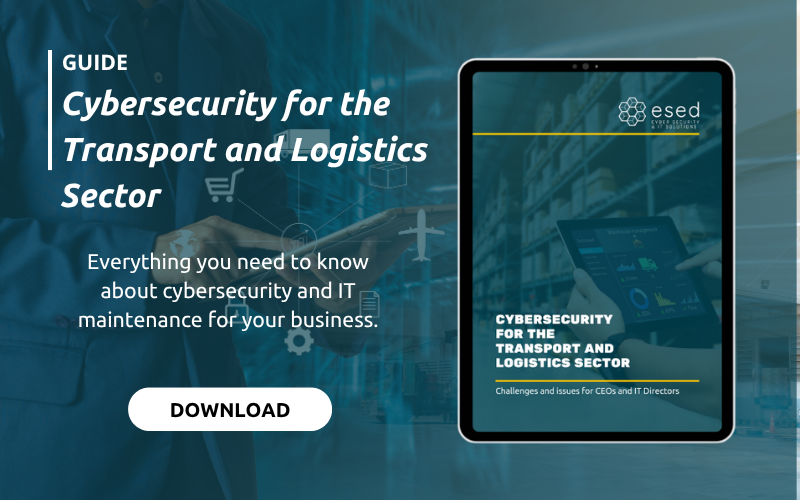Ransomware cyberattacks against the logistics sector
By Eduard Bardají on Oct 28, 2025 2:56:26 PM

Logistics no longer moves only through roads, ports, or warehouses — it also flows through networks, systems, and data.
A cyberattack, whether ransomware, credential theft, or even an intrusion through a supplier, can stop routes, block warehouses, or bring all operations to a halt.
Protecting business operations to avoid disruptions requires implementing a cybersecurity strategy tailored to the company’s needs, including: XDR/MDR solutions, endpoint management, supply chain controls, backups, and cybersecurity training for the entire organization.
Ransomware cyberattacks against the logistics sector
The logistics sector relies on the constant sharing of systems and data across an extensive network (carriers, ports, warehouses, suppliers). These interactions and the continuous exchange of data, without proper cybersecurity measures, pose a significant security risk to companies. Even a small security breach can rapidly spread and compromise the entire supply chain, affecting multiple entities and systems simultaneously.
The widespread adoption of the Internet of Things (IoT), through trackers, sensors, and smart cameras, has significantly expanded the attack surface of IT infrastructures. These devices, often with limited security, create additional entry points that cybercriminals can exploit to access the network and sensitive information.
In the logistics and transportation sector, a disruption in systems can lead to operational delays, financial losses, and a loss of customer trust.
Consequences of a ransomware cyberattack in the logistics and transportation sector
A cyberattack in logistics is not just about data loss, it results in a complete operational shutdown. Disrupting systems such as warehouse management or fleet tracking halts the flow of goods. This leads to downtime, missed deadlines, and a collapse in service availability on a global scale.
The logistics network contains multiple vulnerabilities. Attackers use social engineering, for example, phishing, to steal employee credentials. Access can also be gained through supplier systems or insecure IoT devices that act as backdoors into the corporate network. Additionally, compromising third-party software is a high-risk vector for introducing malware.
Ransomware attacks often employ double extortion, complicating response efforts. This tactic involves two layers of blackmail: first, encrypting and locking data to paralyze operations, and second, exfiltrating sensitive information (customer or financial data) with the threat of publishing it. This creates a privacy crisis and legal exposure that increases pressure to pay the ransom.
Most common types of ransomware attacks in the sector
Ransomware as a Service (RaaS)
RaaS is the structure that enables cybercriminals to carry out ransomware attacks. Developers rent out their tools to others, lowering the entry barrier for launching sophisticated attacks. This drives a global increase in incidents, making vigilance with XDR/MDR solutions essential.
Encryption ransomware
This is the most dangerous and widespread variant, and the foundation of double extortion. It encrypts critical files and data on infected devices and network drives. By compromising WMS or TMS data, it paralyzes management, billing, and goods traceability.
Locker ransomware
This variant completely blocks access to the operating system, preventing use of the device. Although it does not encrypt files, it halts operations by disabling terminals or critical workstations in warehouses.
Real cases and their impact
- Maersk (2017): A NotPetya ransomware attack shut down its global systems. More than 4,000 servers and 45,000 computers were affected. Estimated losses: $300 million.
- Expeditors International (2022): A ransomware attack stopped its worldwide logistics operations for weeks.
- Pitney Bowes (2019): The mailing services provider was hit by ransomware; customers were unable to use online services for days.
Cybersecurity tips to prevent ransomware attacks
Preventing ransomware in logistics and transportation goes beyond having a good antivirus or firewall. It involves building a layered defense, where each level acts as a barrier to stop the spread of an attack, minimizing its impact if it occurs.
Endpoints with XDR/MDR technology
Implementing XDR or MDR solutions allows organizations to detect unusual or anomalous behavior, isolate compromised devices, and automatically eliminate threats before they can spread across the network and infect other devices. Additionally, these solutions provide traceability, meaning you can know which device was infected, how it was infected, and what caused the infection.
Intelligent backups (3-2-1 del backup rule)
Having backups is essential, but a single backup is not enough, as it can also be compromised by cybercriminals. The key is to follow the 3-2-1 backup rule:
-
3 – copies of your data (one primary and two backups).
-
2 – different storage media (e.g., cloud and physical storage).
-
1 – an offline or immutable copy that cannot be encrypted during an attack.
Suply chain security
Ransomware often enters not through the affected company’s own systems, but via a supplier or technology partner.
For this reason, when working with technology partners, they should meet minimum cybersecurity controls and standards, such as:
- Limited access with multi-factor authentication.
- Regular review of shared credentials.
- Periodic security audits.
Employee training and awareness
Human error accounts for 90% of cyberattacks.
Regular phishing simulations and practical training help employees recognize suspicious emails or unusual behavior before it’s too late.
Continuous monitoring and early detection
Implementing 24/7 monitoring of critical systems (servers, WMS, TMS, corporate email) allows organizations to detect anomalous patterns before ransomware is executed.
Protection against ransomware in logistics does not rely on a single tool, but on a well-planned strategy coordinated between company leadership and the IT and cybersecurity departments.
At ESED, we offer anti-ransomware cybersecurity solutions to help companies mitigate the risks and threats associated with attacks of this magnitude. Additionally, we work with fixed monthly rates and no long-term commitments, allowing us to adapt to the specific needs of each company.
You May Also Like
These Related Stories

Challenges and solutions for securing IoT devices in enterprises

Consequences of not having cybersecurity in your company





.png?width=262&height=150&name=accio-10-negre%20(1).png)

